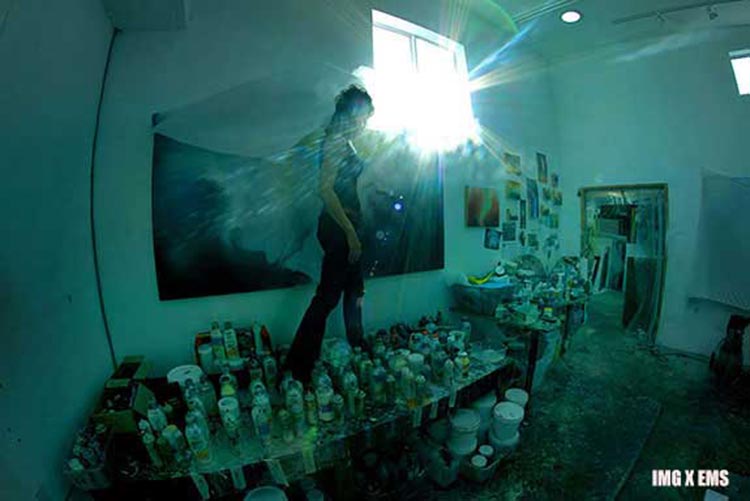
Suzan Woodruff was born in Phoenix, AZ. From an early age, she began exploring the desert, immersing herself in endless spaces and spectacular natural vistas that would later become essential to her art. She was raised by her gold-prospector grandparents who taught her how to “read” rocks and by her mother, who lived a distinctly Arizona-bohemian lifestyle. She remains an avid hiker, biker, boogie boarder and readaer of rocks as well as books. Woodruff received an art scholarship to attend Arizona State University. She soon began exhibiting her work and left Arizona for Los Angeles and New York. Currently, she resides in Los Angeles with her husband Bruce Bauman and their two dogs.
Shana Nys Dambrot
Suzan Woodruff makes ethereal, viscous, shimmering paintings that look nothing like the sexualized, narrative, extremely figurative and frequently self-portrait-based work of the late Ana Mendieta. They look even less like the work of Artemisia Gentileschi, Joan Mitchell, Georgia O’Keeffe, Nancy Spero, or Marina Abramovic. Yet in a very real sense, Woodruff is the spiritual and art historical heir to those women and to the many vectors of their careers. These art-historical kinships transcend formal influences, giving rise to Woodruff’s glorious abstract allegories, her non-figurative feminist pictures, which bring to the surface what has been sublimated — even as her surface is where all the action is. But then again, her Burning Woman series — a periodically revisited performance project based on a ritual burning and with conceptual roots in related paintings — does look very much like something Mendieta might have done; in the use of earth, air and fire, the direct references to the/her own female body, the performative element, the mass, the totemic, pagan magic at the heart of it — all transformed through the prism of art.
So how can Woodruff have ancestors like those and yet make such lyrical, sumptuous, aggressively beautiful work? The answer lies just beneath those iridescent, mesmerizing surfaces — beyond what one sees in the picture and into what one knows to be true about the world. “Sometimes I feel like I’m channeling the universe, working in a kind of trance like a deep meditation,” Woodruff says. “In the studio, I also use my body, but to paint instead of burn.” In her paintings she contains and choreographs her self-engineered chaos through a proprietary, durational, and seriously physical process, involving constant motion and remaining open to “apparitions and visitations,” and what she invokes Leonard Cohen in calling the “cracks where the light comes in.” Her micro/macro, fractal-friendly point of view hinges on her belief in the essential interconnectedness of all light and all darkness, all space and all matter — and that includes living beings.
Like another of her art-historical ancestors, J.M.W. Turner, Woodruff takes artistic license with science and industry. There’s a voice of sense-memory and atavistic dream-time that sings a primordial lullaby of fractals and whirlwinds in her process that is about not depicting, but instead replicating natural phenomena — from the cellular level to the sweep of dust storms, undersea volcanoes, wildfire, rushing water, flocking birds, the contours of a fjord, hurricanes seen from space, clouds of steam and rain, and even ghosts haunting the harbor. This pattern-seeking with an unapologetically spiritual insight does directly invigorate her relationship not only to Turner but also to Frankenthaler and O’Keeffe — both of whom also worked along this abstraction/humanism/naturalism continuum, and both of whom knew very well that the world isn’t always trying to hear it from a lady.
Letting go of the need to control and dominate the laws of nature is scary to some people. That letting go is operative in Woodruff’s process, generating an allegorical abstraction in which the method of formal execution is more than a means to an aesthetic end, but integral to the armature of meaning. That form/content dynamic is a vector of the persistent perception of the feminine as a dangerous force. And indeed it is a fine primal line between desire and fear. Some say that’s why Mendieta died, victim to a terror of the very untamable, ancient feminine energy she was courting and creating in her work. Someone once said to Woodruff, “I can’t decide if your painting looks like the beginning or the end of the world.” Her reply? “Why not both?”